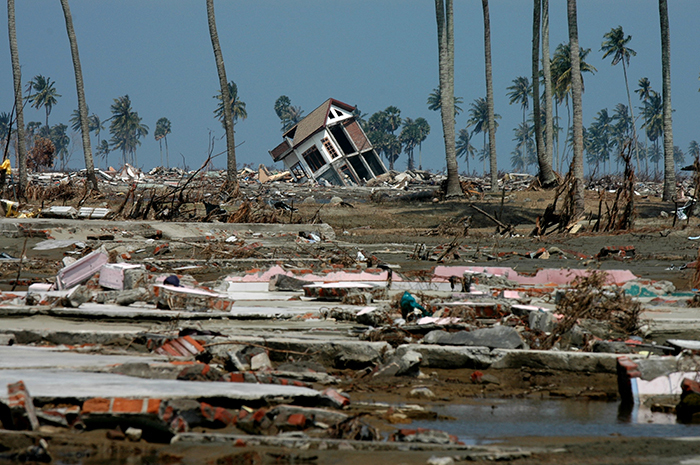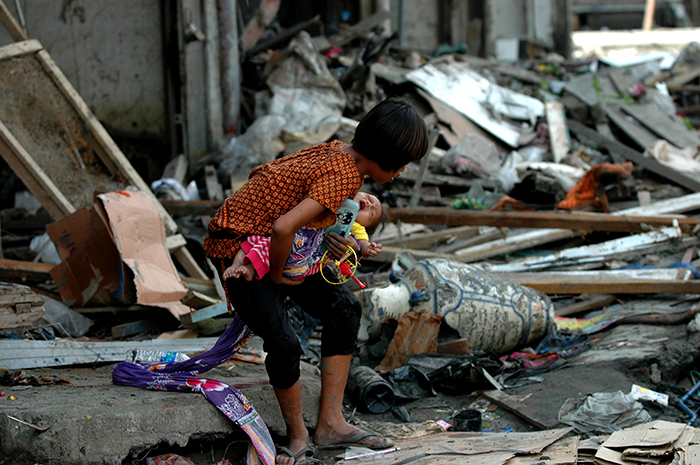Case Study: Sumatra and Thailand and the 2004 Tsunami
The Importance of Tsunami Warning Systems and the challenges of warning communication.
Think back to the video you watched in Module 7 – which included scenes of the 2004 tsunami event in Indonesia. The beginning of the video focused on the Banda Aceh area of Sumatra, where fishing communities and small coastal cities were completely destroyed, and the end of the video featured the Phuket area, where more tourist beaches were affected.
Through your reading and watching the videos, you hopefully gained an idea of what it is like to be caught in a tsunami with no advanced warning, and how frantic the attempts to get out of the way must be. Imagine what it would be like to try to move small children, sick or elderly people out of the way of a tsunami with before the wave strikes and with no time to spare!
In Module 7, the events in Phuket, Thailand, are described, with tourists enjoying their vacation on the beach at Christmas 2004. Many are oblivious to the dangers of the approaching tsunami. What could have been done differently? If this were to happen again, would these communities be better informed and prepared?
In Module 7 we also mentioned that early warning systems are very tricky because of the challenges of getting the message out soon enough after the earthquake and before the tsunami waves arrive at a particular shoreline. For example, the towns on the west coast of Sumatra are so close to the Andaman fault that they had almost no time to react, so a warning may not have worked, regardless of how well it was transmitted. Banda Aceh, on the northern tip of Sumatra, was devastated in 2004 because people did not have time to react, while there is evidence that some small nearby island communities fared better where traditional knowledge of the natural warning signs such as the sudden receding of the tidal waters was employed, and residents were able to flee to higher ground. Meanwhile, the tourist destinations of Phuket and Phi Phi, and nearby locations in Thailand had 2 hours, but the warnings were lacking. Visitors lacked necessary knowledge of nature’s warning signs and how to react, and may not have felt the earthquake, so many lives were lost.
In response to the enormous loss of life in the 2004 Indian Ocean tsunami, the Global Tsunami Warning and Mitigation System was put in place. The Indian Ocean tsunami warning system now integrates the signals from seismographs and DART Buoys and transmits data to 26 national centers. Warnings at the local level are generated in the form of SMS messages, mosque loudspeakers, sirens, and other methods to warn citizens. How well the warnings translate into lives saved due to rapid response and appropriate behaviors by the citizens depends on each step working properly. The failure of one of the steps can lead to disaster. If the citizens do not have the knowledge needed to take effective action, then the process will not work, and lives will be lost.
In 2012 another earthquake occurred near Banda Aceh in the Indian Ocean, so the newly implemented warning systems were put to the test. In this case, no tsunami was generated by the earthquake, but unfortunately, the weaknesses in the system were revealed. Despite the efforts expended to increase levels of tsunami preparedness since 2004, including new tsunami evacuation shelters and education programs, chaos ensued. Hearing the tsunami warning, people panicked and tried to flee by car, resulting in gridlock on the roads. It was clear that better guidance from the local government was needed, including clear evacuation route signage and regular drills. For more detail on this topic, read the National Geographic article Will Indonesia Be Ready for the Next Tsunami? Clearly, more work is still needed and ongoing to address these weaknesses.


Learning Check Point
We will spend a few minutes also revisiting the accounts of historic tsunami events – in particular, the 1960 event and its effects in Chile and Hilo, Hawaii, and the important messages about how to survive a tsunami. Please re-read some of the accounts of survival during tsunami events in Heed Natural Warnings.
